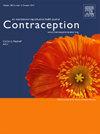用简表避免怀孕意愿量表推进对怀孕偏好的创新测量
IF 2.8
2区 医学
Q1 OBSTETRICS & GYNECOLOGY
引用次数: 0
摘要
避免怀孕意愿量表(DAP)是怀孕 "意愿 "测量的重要一步。该量表包含 14 个心理测量项目,可跨领域(认知、情感、后果)前瞻性地捕捉怀孕偏好,并可考虑细微差别、不确定性和矛盾心理。然而,我们需要一个 DAP 短式量表来减轻受访者的负担,并促进将这一严格的、以人为本的测量方法纳入未来的研究和监测中。方法我们使用了来自美国九个不同州的 >30,000 名自我认同的 18-44 岁女性的州代表性数据(妇女调查,2017-2023 年),开发了一个四项目版本的 DAP 量表(DAP-4)。在按州将数据集一分为二后,我们使用经典测验理论和项目反应理论方法反复确定了一个缩小的项目集,该项目集保持了建构效度(例如,包含跨概念领域的项目,并采用了否定和肯定的措辞)、内部结构效度(例如,单调性)和外部效度(例如,无差异项目功能),同时保持了合理的内部一致性可靠性。结果 DAP-4 包括认知领域的两个项目、情感和实际后果领域的各一个项目以及双向措辞的项目。短式问卷的内部一致性很高(α=0.83),涵盖了所有受访者的怀孕偏好,并符合内部结构有效性的标准。我们没有发现不同年龄、种族和民族、关系状况或胎次的项目功能有差异,而且与较长的 DAP 量表有很高的相关性(0.96)。本文章由计算机程序翻译,如有差异,请以英文原文为准。
ADVANCING INNOVATIVE MEASUREMENT OF PREGNANCY PREFERENCES WITH A SHORT-FORM DESIRE TO AVOID PREGNANCY SCALE
Objectives
The Desire to Avoid Pregnancy (DAP) Scale represents an important step forward for pregnancy “intention” measurement. The 14-item psychometric instrument captures pregnancy preferences prospectively across domains (cognitive, affective, consequences) and allows for nuance, uncertainty, and ambivalence. However, a DAP short-form scale is needed to reduce respondent burden and facilitate integration of this rigorous, person-centered measure into future research and surveillance.
Methods
We used state-representative data from >30,000 self-identified women, aged 18-44 years, from nine diverse US states (Surveys of Women, 2017–2023) to develop a four-item version of the DAP scale (DAP-4). After splitting the dataset in half, stratified by state, we used classical test theory and item response theory methods to iteratively identify a reduced item set that maintained construct validity (eg, included items across conceptual domains and were worded negatively and positively), internal structure validity (eg, monotonicity), and external validity (eg, no differential item functioning), while maintaining reasonable internal consistency reliability. Scale properties were retested on the second half of the dataset.
Results
The DAP-4 included two items in the cognitive domain and one each in the affective and practical consequences domains, and items worded in both directions. The internal consistency was high for a short-form (alpha=0.83), covered the full range of respondent pregnancy preferences, and met criteria for internal structure validity. We found no evidence of differential item functioning by age, race and ethnicity, relationship status or parity, and high correlation with the longer DAP scale (0.96).
Conclusions
A short-form DAP that maintains psychometric rigor is now available to measure pregnancy preferences.
求助全文
通过发布文献求助,成功后即可免费获取论文全文。
去求助
来源期刊

Contraception
医学-妇产科学
CiteScore
4.70
自引率
17.20%
发文量
211
审稿时长
69 days
期刊介绍:
Contraception has an open access mirror journal Contraception: X, sharing the same aims and scope, editorial team, submission system and rigorous peer review.
The journal Contraception wishes to advance reproductive health through the rapid publication of the best and most interesting new scholarship regarding contraception and related fields such as abortion. The journal welcomes manuscripts from investigators working in the laboratory, clinical and social sciences, as well as public health and health professions education.
 求助内容:
求助内容: 应助结果提醒方式:
应助结果提醒方式:


